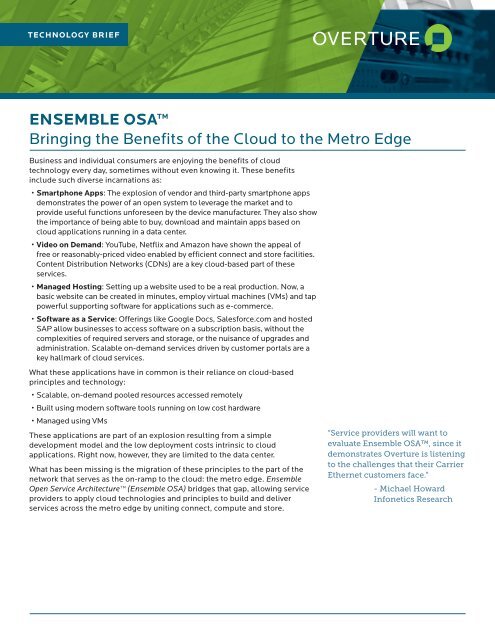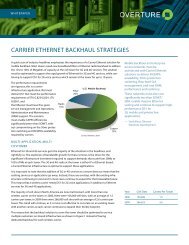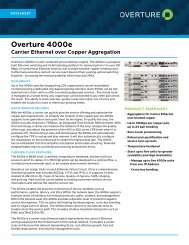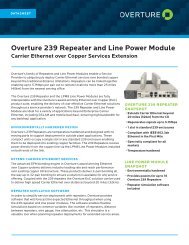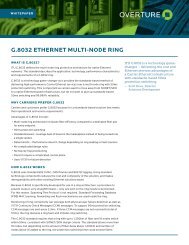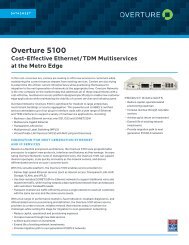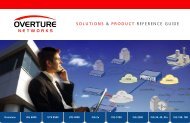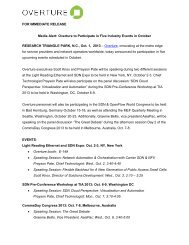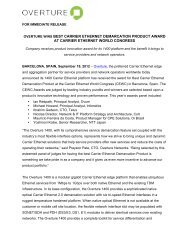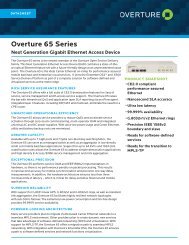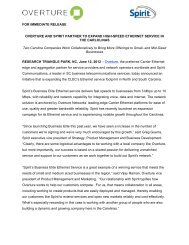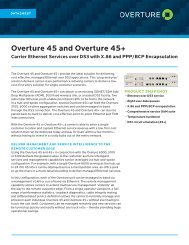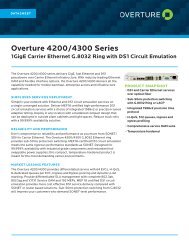Ensemble OSA - Overture Networks
Ensemble OSA - Overture Networks
Ensemble OSA - Overture Networks
You also want an ePaper? Increase the reach of your titles
YUMPU automatically turns print PDFs into web optimized ePapers that Google loves.
TECHNOLOGY BRIEF<br />
ENSEMBLE <strong>OSA</strong><br />
Bringing the Benefits of the Cloud to the Metro Edge<br />
Business and individual consumers are enjoying the benefits of cloud<br />
technology every day, sometimes without even knowing it. These benefits<br />
include such diverse incarnations as:<br />
• Smartphone Apps: The explosion of vendor and third-party smartphone apps<br />
demonstrates the power of an open system to leverage the market and to<br />
provide useful functions unforeseen by the device manufacturer. They also show<br />
the importance of being able to buy, download and maintain apps based on<br />
cloud applications running in a data center.<br />
• Video on Demand: YouTube, Netflix and Amazon have shown the appeal of<br />
free or reasonably-priced video enabled by efficient connect and store facilities.<br />
Content Distribution <strong>Networks</strong> (CDNs) are a key cloud-based part of these<br />
services.<br />
• Managed Hosting: Setting up a website used to be a real production. Now, a<br />
basic website can be created in minutes, employ virtual machines (VMs) and tap<br />
powerful supporting software for applications such as e-commerce.<br />
• Software as a Service: Offerings like Google Docs, Salesforce.com and hosted<br />
SAP allow businesses to access software on a subscription basis, without the<br />
complexities of required servers and storage, or the nuisance of upgrades and<br />
administration. Scalable on-demand services driven by customer portals are a<br />
key hallmark of cloud services.<br />
What these applications have in common is their reliance on cloud-based<br />
principles and technology:<br />
• Scalable, on-demand pooled resources accessed remotely<br />
• Built using modern software tools running on low cost hardware<br />
• Managed using VMs<br />
These applications are part of an explosion resulting from a simple<br />
development model and the low deployment costs intrinsic to cloud<br />
applications. Right now, however, they are limited to the data center.<br />
What has been missing is the migration of these principles to the part of the<br />
network that serves as the on-ramp to the cloud: the metro edge. <strong>Ensemble</strong><br />
Open Service Architecture (<strong>Ensemble</strong> <strong>OSA</strong>) bridges that gap, allowing service<br />
providers to apply cloud technologies and principles to build and deliver<br />
services across the metro edge by uniting connect, compute and store.<br />
“Service providers will want to<br />
evaluate <strong>Ensemble</strong> <strong>OSA</strong>, since it<br />
demonstrates <strong>Overture</strong> is listening<br />
to the challenges that their Carrier<br />
Ethernet customers face.”<br />
- Michael Howard<br />
Infonetics Research
WHAT IS ENSEMBLE <strong>OSA</strong>?<br />
<strong>Overture</strong>’s <strong>Ensemble</strong> <strong>OSA</strong> is the industry’s first open architecture for softwaredefined<br />
services at the metro edge. <strong>Ensemble</strong> <strong>OSA</strong> optimizes service creation,<br />
activation, and assurance by bringing the benefits of the cloud to the metro edge.<br />
With this new open architecture that incorporates principles of software defined<br />
networking (SDN) and network function virtualization (NFV), service providers are<br />
able to maximize operational efficiencies and introduce new revenue-generating<br />
services faster and easier than ever before.<br />
Before we dig into the details of <strong>Ensemble</strong> <strong>OSA</strong>, let’s take a look at how it<br />
originated.<br />
“<strong>Overture</strong> is advancing<br />
network virtualization with the<br />
introduction of <strong>Ensemble</strong> <strong>OSA</strong><br />
- in effect, pushing the cloud<br />
closer to the network edge and<br />
creating new opportunities for<br />
service providers to meet growing<br />
demand from their customers.”<br />
- Rosemary Cochran<br />
Vertical Systems Group<br />
ENSEMBLE <strong>OSA</strong> - BORN FROM REAL WORLD NEEDS<br />
At <strong>Overture</strong>, we are fortunate to be a trusted partner for many of the world’s<br />
top service providers and network operators. These service providers, through<br />
numerous opportunities, have asked <strong>Overture</strong> to help solve some of their<br />
challenges in optimizing service creation, activation and assurance. Examples<br />
of these requests include:<br />
• Providing Application Programming Interfaces (APIs) to<br />
<strong>Overture</strong>’s Carrier Ethernet equipment that facilitates the<br />
automation of provisioning and management<br />
• Implementing Zero Touch Commissioning across the<br />
<strong>Overture</strong> product line using standard tools and protocols<br />
• Facilitating flow through provisioning in a heterogeneous<br />
environment<br />
• Enabling dynamic bandwidth and simplifying service<br />
assurance in a multi-vendor network<br />
• Building virtual applications such as managed virtual<br />
routing and security<br />
• Bringing the automation features of the public cloud to<br />
private cloud services<br />
As we evaluated each of these customer requests, it<br />
became clear that the most effective way for <strong>Overture</strong> to<br />
deliver on these was to incorporate the concepts of openness, virtualization<br />
and orchestration from the cloud data center into an architecture positioned at<br />
the metro edge. The result: <strong>Ensemble</strong> <strong>OSA</strong>.<br />
OPTIMIZING SERVICE CREATION, ACTIVATION, AND ASSURANCE<br />
Facing intense competition for connect, compute and store services, service providers are<br />
under increasing pressure to rapidly define and turn up services in response to changing<br />
market demands. They are slowed by today’s complicated service creation model – one<br />
where developing a new offering can take 18 months and tens of millions of dollars.<br />
<strong>Ensemble</strong> <strong>OSA</strong> addresses this problem by applying cloud technologies to speed up service<br />
creation, resulting in increased flexibility, virtualization, programmability and intelligence<br />
at the metro edge. <strong>Ensemble</strong> <strong>OSA</strong> accelerates the innovation cycle and reduces the time<br />
and cost of activating customers.<br />
Assuring the performance in today’s multi-vendor environment is also costly,<br />
complex, and usually requires significant manual intervention. <strong>Ensemble</strong> <strong>OSA</strong><br />
radically decreases the cost and complexity of performance assurance by<br />
leveraging intuitive, intelligent, and automated tools.<br />
2
ENSEMBLE <strong>OSA</strong> - BUILT ON REAL WORLD SOLUTIONS<br />
A fundamental principle of <strong>Ensemble</strong> <strong>OSA</strong> is that it incorporates the latest in<br />
open cloud-based technologies.<br />
• Open Standards – One reason for the explosion of cloud-based applications<br />
and services is the large ecosystem of tools and open standards. You don’t<br />
have to start from scratch when building a new service. Instead, you can<br />
leverage a large base of proven software and services. This drastically<br />
simplifies and accelerates the job.<br />
• Network Function Virtualization (NFV) – NFV expands the principles of<br />
virtualization beyond the data center and into the metro edge. Using NFV,<br />
applications such as routing, firewalls and virtual private networks (VPN) can<br />
be moved from custom hardware to software applications running in VM on<br />
commercial servers.<br />
• Software Defined Networking (SDN) – SDN allows for the separation of<br />
control and data simplifying how networks are built. This dramatically<br />
reduces cost by moving functions from high-cost custom hardware to<br />
centralized servers. SDN also provides for APIs and programmability,<br />
supporting the development of new applications without the need to<br />
change underlying hardware.<br />
• Metro Edge – This is the on-ramp of the network. For today’s networks,<br />
it’s where much of the cost, complexity and congestion is concentrated. At<br />
<strong>Overture</strong>, we are leveraging our experience in the metro edge and applying<br />
<strong>Ensemble</strong> <strong>OSA</strong> to address these key issues.<br />
ENSEMBLE <strong>OSA</strong> TECHNICAL OVERVIEW<br />
<strong>Ensemble</strong> <strong>OSA</strong>’s structure is comprised of three levels: Resources,<br />
Orchestration and Control and Network Applications. Each of these<br />
communicates through a set of standards-based and open APIs.<br />
Open<br />
Standards<br />
Software<br />
Defined<br />
Networking<br />
Metro<br />
Edge<br />
Network<br />
Function<br />
Virtualization<br />
“<strong>Ensemble</strong> <strong>OSA</strong> is a bold step<br />
forward in advancing these<br />
concepts at the metro edge and<br />
it should really help service<br />
providers reduce expenses<br />
while opening the door to a new<br />
opportunities.”<br />
- Nav Chander<br />
IDC<br />
RESOURCES<br />
Resources provide connect, compute and storage functionality. They may<br />
consist of physical devices such as switches, servers and storage arrays, and/or<br />
software functions running in a VM. Examples include:<br />
• <strong>Overture</strong> devices for high performance networking – When performance<br />
is important, there is no substitute for purpose-built hardware. <strong>Overture</strong>’s<br />
solutions include open APIs for virtualizing management, configuration and<br />
data plane control functions.<br />
• High-performance commercial appliances – This includes the compute<br />
servers and storage appliances found in modern data centers.<br />
• Third party network element integration – The <strong>Ensemble</strong> <strong>OSA</strong> framework will<br />
be extended to include network devices from other vendors.<br />
Resources communicate northbound with the Orchestration and Control layer<br />
using modern standard APIs such as OpenFlow, SOAP/SML and Netconf, but<br />
also through traditional interfaces and protocols such as SNMP and SSH/CLI.<br />
ORCHESTRATION AND CONTROL<br />
<strong>Ensemble</strong> <strong>OSA</strong>’s orchestration and control layer consists of building block<br />
functions that provide the glue connecting the applications to the resources:<br />
• Data Plane Control – <strong>Ensemble</strong> <strong>OSA</strong> leverages existing solutions such as<br />
OpenFlow controllers to manage the data plane.<br />
• Resource Abstractions – <strong>Overture</strong>’s open architecture provides a simplified<br />
model for configuring and monitoring multi-vendor network, computing and<br />
storage resources. This includes building blocks for CoS/QoS, device inventory<br />
and network topology as well as tools for managing virtual resources through<br />
cloud management suits, such as OpenStack or CloudStack.<br />
3
• Management – <strong>Ensemble</strong> <strong>OSA</strong> includes functions such as:<br />
• Fault and performance management to assure SLA performance<br />
• Commissioning to support new installations<br />
• Alarming to handle faults<br />
• Test head functions to facilitate diagnosis and repair activities<br />
NETWORK APPLICATIONS<br />
The simplified development and integration of network applications is<br />
where the open and scalable nature of <strong>Ensemble</strong> <strong>OSA</strong> really pays off.<br />
Network Applications are software packages that leverage one or more of the<br />
Orchestration and Control building blocks and tie into back<br />
office systems of the service provider and their business<br />
partners to create a service or network function. These<br />
applications fall into two main categories:<br />
• New Revenue Generating – These network applications<br />
provide the service provider with a new path to net revenue,<br />
either through expanding the market for an existing service<br />
or by facilitating the development of a new service.<br />
• Operational Efficiency – For modern service providers,<br />
operational expenses outweigh capital expenses by a ratio<br />
of five to one – or higher. Applications that reduce these<br />
operational expenses provide an immediate benefit to the<br />
bottom line.<br />
<strong>Ensemble</strong> <strong>OSA</strong>’s open nature means that these network applications can be<br />
supplied by <strong>Overture</strong>, the service provider or a third party.<br />
ENSEMBLE <strong>OSA</strong> USE CASES – HIGHLIGHTING THE BENEFITS<br />
The nearby figure provides a summary of use cases that support service<br />
creation, activation and assurance. Two of these cases are detailed in the<br />
following sections.<br />
USE CASE – ZERO TOUCH COMMISSIONING<br />
Service providers are actively seeking ways to accelerate<br />
service activation while lowering their operational costs.<br />
One effective way to do so is to simplify installation and<br />
configuration of their customer located network interface<br />
device (NID). In the personal computer world, the model<br />
is “plug and play,” where the user doesn’t have to do any<br />
additional configuration to use a peripheral. In <strong>Ensemble</strong><br />
<strong>OSA</strong>, this notion is called Zero Touch Commissioning (ZTC).<br />
The process of ZTC includes a number of phases:<br />
• Installation – Depending on the service type and access link,<br />
NID installation can be done by either a service provider’s<br />
technician or by the customer.<br />
• Discovery – Once the NID is connected and powered up, it<br />
announces itself to the network over its uplink. The NID is<br />
recognized based on an identifier such as its serial number,<br />
Media Access Control (MAC) address or aggregator port. A<br />
ZTC app records the fact that the NID is now installed.<br />
• Reachability – An upstream server sends the NID its<br />
reachability information, such as IP address, default gateway,<br />
subnet mask and/or management VLAN. At this point, the<br />
NID is reachable by standard IP protocols.<br />
4
• Software updates – The next step is to ensure that the NID has the correct<br />
software version installed. The ZTC app determines the appropriate software<br />
based on the device and application.<br />
• Configuration – Once the NID is reachable and is loaded with the correct<br />
software, it can receive its initial or commissioning configuration file. Typically,<br />
this includes invariant items such as device name, location, uplink parameters,<br />
etc.<br />
Now, the NID is ready for services to be activated – all without an operator<br />
having participated in any steps beyond connecting and powering the NID.<br />
By automating the steps above and tying the actions into standard servers, the<br />
whole process of connecting a customer is accelerated and optimized. This<br />
process goes from being driven by calendars and checklists to being driven by<br />
events and interaction with standard servers.<br />
“By compressing the innovation<br />
cycle to better address the<br />
evolving needs of enterprise<br />
business, wholesale, mobile, and<br />
residential end users, <strong>Overture</strong>’s<br />
<strong>Ensemble</strong> <strong>OSA</strong> will enable<br />
carriers to be more agile and<br />
give them greater flexibility in<br />
responding to rapidly changing<br />
market dynamics.”<br />
- Ray Mota<br />
ACG Research<br />
Based on analysis done with a major North American service provider, Zero<br />
Touch Commissioning can result in a 75% reduction in installation cost and<br />
up to a 60% reduction in installation time.<br />
USE CASE – VIRTUAL ROUTING/VIRTUAL PRIVATE NETWORK (VPN)<br />
Today, service providers use routers deployed at the customer site to provide<br />
managed router and VPN services. In particular, Layer 3 VPNs are built using<br />
this approach. A router at the customer premises (CPE) adds<br />
cost and complexity to the deployment and operation of<br />
these managed services.<br />
<strong>Ensemble</strong> <strong>OSA</strong> provides the means to simplify this service by<br />
moving the routing function from the CPE into the network<br />
using the principles of NFV.<br />
With <strong>Ensemble</strong> <strong>OSA</strong> and NFV, the service provider can deploy<br />
a simple low cost CPE for all applications. Value added<br />
services, such as managed routers and Layer 3 VPNs, can be<br />
added on demand without changing the CPE. Other benefits<br />
of this approach include reducing CPE obsolescence and<br />
minimizing the of impact of service changes.<br />
This last point is particularly important. Today, the cost of<br />
doing software upgrades to CPE routers is tremendous.<br />
• First, a service window has to be negotiated with the<br />
customer. Often, there are contractual limitations on how<br />
often this can occur, as well as on much notice must be given.<br />
• Next, the software must be downloaded. The size of the<br />
software image and the low speed of some access links<br />
forces the download to be scheduled for off-peak periods<br />
and/or downloaded at a shaped rate.<br />
• Finally, activating the new software includes a reboot of the CPE. The operation<br />
of the service then must be verified after the new software is up and running.<br />
The steps above can be reduced or eliminated when the routing function is<br />
virtualized and moved to software running in a VM. The service provider can<br />
realize a 50% reduction in capital expense costs and a 50% savings in<br />
operational expenses.<br />
5
USING THE CLOUD TO CREATE, ACTIVATE AND ASSURE<br />
<strong>Ensemble</strong> <strong>OSA</strong> brings the power of the cloud to the metro edge enabling the<br />
rapid innovation of new services along with radical cost reductions.<br />
PRESENT MODE<br />
Static, rigid, decoupled<br />
services<br />
18 months, $21M to<br />
create a new service<br />
(tier-1 service provider)<br />
Barrier to innovation and<br />
change<br />
Manual adds/moves/<br />
changes<br />
Complex back-office<br />
integration expense<br />
consumes 65%-85% of<br />
budget<br />
Dumb pipes, best effort<br />
services<br />
Manual complex fault<br />
management<br />
Reactionary, decoupled<br />
from service<br />
WITH ENSEMBLE <strong>OSA</strong><br />
Dynamic, flexible, appaware<br />
New services in weeks<br />
Reduced cost to innovatequickly<br />
respond to market<br />
opportunities<br />
Reduce or eliminate truck<br />
rolls<br />
Changes in minutes, not<br />
days<br />
Open architecture and<br />
automation reduce time<br />
and operational expenses<br />
Intelligent, per-flow<br />
fault and performance<br />
management<br />
Automated and intuitive<br />
Continuous, real-time,<br />
integrated<br />
ACRONYMS<br />
API Application Programming Interface<br />
CDN Content Distribution <strong>Networks</strong><br />
MORE INFORMATION<br />
<strong>Overture</strong> <strong>Networks</strong> is proudly introducing <strong>Ensemble</strong> <strong>OSA</strong> to the market. To<br />
learn more about industry’s first open architecture for software-defined<br />
services at the metro edge and how it can help you, please contact us at<br />
info@overturenetworks.com.<br />
ABOUT OVERTURE<br />
<strong>Overture</strong> is the preferred provider of Carrier Ethernet solutions for the metro<br />
edge. Known for innovative solutions that enable high-capacity Ethernet<br />
services over any media including fiber, copper and TDM, <strong>Overture</strong> has<br />
extended its commitment to innovation with <strong>Ensemble</strong> <strong>OSA</strong>. <strong>Ensemble</strong> <strong>OSA</strong><br />
is the industry’s first open architecture that brings the benefits of the cloud,<br />
Software Defined Networking (SDN), Network Function Virtualization (NFV)<br />
and open innovation to the metro edge. By leveraging <strong>Overture</strong>’s Carrier<br />
Ethernet expertise and this new open architecture for software-defined<br />
services, network operators and service providers worldwide can maximize<br />
operational efficiencies and introduce new revenue-generating services on a<br />
scale never before possible.<br />
<strong>Overture</strong> is headquartered in Research Triangle Park, NC, with sales offices<br />
around the globe. For more information, visit www.overturenetworks.com.<br />
CLI<br />
CoS<br />
CPE<br />
IP<br />
MAC<br />
NFV<br />
NID<br />
<strong>OSA</strong><br />
QoS<br />
RFC<br />
SDN<br />
SML<br />
SNMP<br />
SOAP<br />
VM<br />
VPN<br />
ZTC<br />
Command Line Interface<br />
Class of Service<br />
Customer Premises Equipment<br />
Internet Protocol<br />
Media Access Control<br />
Network Function Virtualization<br />
Network Interface Device<br />
Open Services Architecture<br />
Quality of Service<br />
Request for Comment<br />
Software Defined <strong>Networks</strong><br />
Service Management Language<br />
Simple Network Management Protocol<br />
Simple Object Access Protocol<br />
Virtual Machine<br />
Virtual Private Network<br />
Zero Touch Commissioning<br />
OVERTURE<br />
<strong>Overture</strong> <strong>Networks</strong>, Inc.<br />
Research Triangle Park, NC<br />
tel: +1.919.387.4100<br />
www.overturenetworks.com<br />
© 2013 <strong>Overture</strong> <strong>Networks</strong>, Inc. All rights reserved. WP-ENS-030813


